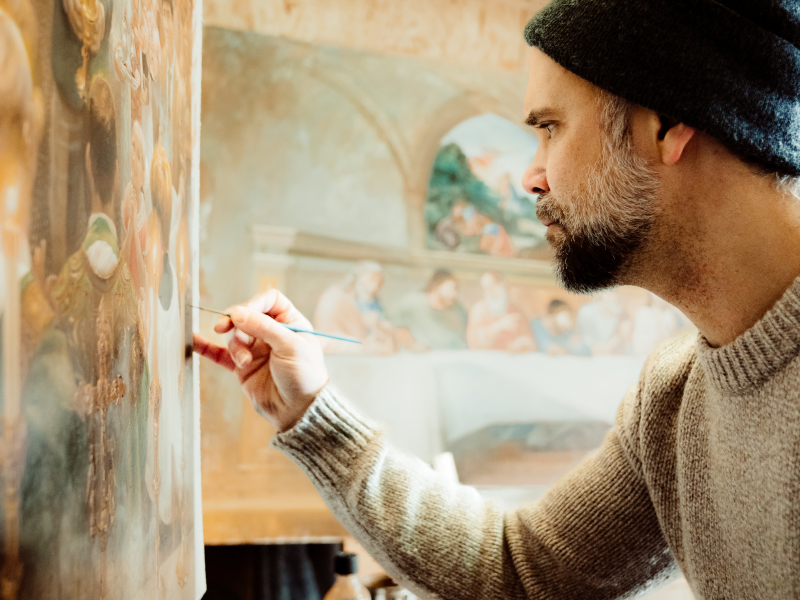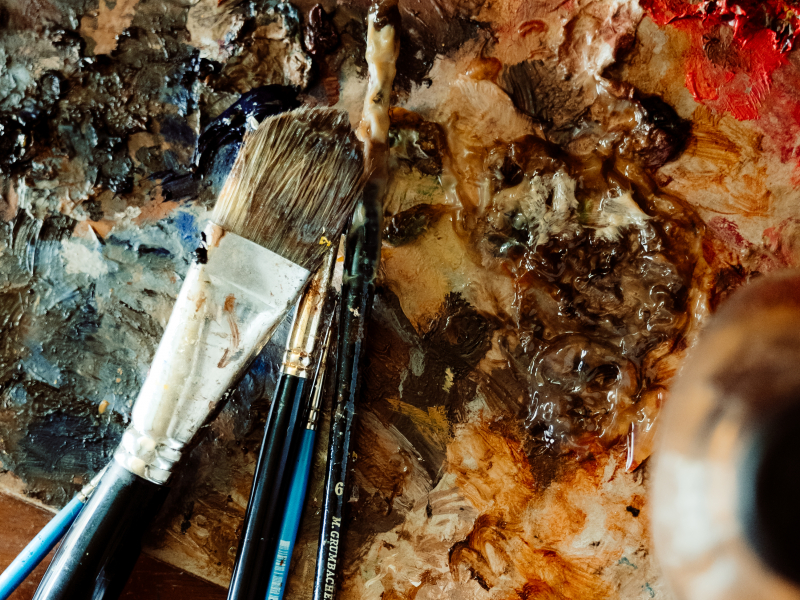
The striking artwork featured in the publicity materials for the Diocese of Lansing's Diocesan Services Appeal 2024 features the work of Jackson-based artist, Joseph Jude Macklin.
The painting depicts a family presenting the gifts to the priest during the Offertory at Holy Mass. The image is inspired by the Sacred Scripture verse for this year’s appeal which is drawn from the book of Sirach: “The offering of the just enriches the altar.” (Sir 35:8).
40-year-old Joseph is a parishioner at Saint Mary Star of the Sea along with his wife, Carly, and their two daughters, Josephine and Eloise. Joseph is an alumnus of Lumen Christi Catholic High School in Jackson and Columbus College of Art and Design in Ohio. In 2020 he established the Instrumentum Dei Studio in Jackson to focus on devotional and liturgical art. Here's a great Q&A with Joseph published in this month's FAITH Magazine:
FAITH Magazine: The Diocesan Services Appeal (DSA) is essential to funding the day-to-day apostolates of the Diocese of Lansing, including such things as seminarian education and many charitable works. How did you feel when asked to create this year’s DSA image?
Joseph Macklin: I felt grateful and honored to have been asked to co-create this year’s DSA image. I say “co-create” because any project from the Instrumentum Dei Studio is produced in a spirit that recognizes that it’s not just the painter who brings a project to fruition — our heavenly Father is the ultimate author and the ultimate creator.
FAITH Magazine: The sacred Scripture verse for this year’s Diocesan Services Appeal is drawn from the book of Sirach: “The offering of the just enriches the altar.” (Sir 35:8). You were given an artistic brief by the Diocese of Lansing of depicting this verse with an image of a family making an offering at Holy Mass using the work of the U.S. illustrator Norman Rockwell (1894-1978) as a suggested artistic influence. How did you then set about developing this commission?
Joseph Macklin: As with all projects and commissions, ideas and requests were brought forth. With collaboration, an initial foundation was developed and I then proceeded to produce three concepts that showcased alternative perspectives. These concepts incorporated the primary elements and objective of the project. A concept was selected and a novena to St. Joseph (patron saint of workers) was offered for his intercession over the project's success.
Since the painting, by request, was to be reminiscent of a Norman Rockwell illustration, I immediately studied what I could on that particular artist’s style. Next up, I contacted family, friends, and others within our parish community who might stand in as models — and be forgiving if any details weren’t right — for photographic reference. This was standard practice for Norman Rockwell. Photography for the project took place after Mass one Sunday. From there, photos were carefully selected to arrange and draw the composition large enough to incorporate the key details addressed in the brief and then sent for approval. Painting ensued for about a month and wrapped up once the photo shoot for this article was completed.
FAITH Magazine: What part does prayer, meditation, adoration and, even, mortification play in the way you develop a commission?
Joseph Macklin: All the above factors are a part of my daily practice to varying degrees, and they are all essential elements of the Instrumentum Dei Studio. I will describe a typical day where those factors are incorporated while working a requested commission.
Wake-up time is around three a.m. as an homage — an offering with whatever follows on that day — to the Holy Trinity. Fasting for the day, when best practiced (it doesn’t always work out this way) is black coffee, water, and one large meal at supper time. I see this as mortification as there are always points where I’d like to give in to appetite and distraction throughout the day. Sweetened coffee with cream sounds good. However, even the bitter bite of black coffee can seem to be a prayer from time to time and a reminder that coffee is a gift. This helps me to focus and, at times, pray — in the form of conversation as if the Lord is right next to me or in front of me — for perseverance and guidance in the work at hand.
I often create in complete silence to meditate or listen for God’s voice throughout the project. When not in silence, I will listen to musical arrangements, which may include Palestrina, the Tallis Scholars or Bach’s cello suites. It often helps to focus by having beautiful arrangements to listen to. Finally, there are times when I also burn incense with fragrances reminiscent of the ones from Holy Mass.
FAITH Magazine: Tell us about the completed painting. What are we looking at? What are the things we should look for in the details?
Joseph Macklin: As mentioned, the painting is illustrative, which means that there were real people as models for the image, yet the composition in those photos and the people have been manipulated to tell a story. The point during Holy Mass represented in this illustration is when a family brings offertory gifts to the priest.
The story told visually is underscored by that scripture verse from the Old Testament: “The offering of the just enriches the altar.” (Sir 35:8) In this image, the congregation participates, looking on as the father of the family brings up the offertory gifts with his wife and their children in order to present them to the priest. A heavenly glow is cast from the lights above down onto the heads of each participant. The altar where the consecration takes place is just behind the priest, deacon and altar servers, where incense can also be seen, signifying further what the scripture verse continues, “offering a pleasing odor to the Lord.”
A particular detail to note is the light, central and near the top of the painting, glowing yet in a shape reminiscent of the Holy Spirit. Additional custom elements include the lid to the ciborium, which is carried and offered by the father. This reflects a model of St. Mary Cathedral, symbolizing the Diocese of Lansing and the gift of the faith. The younger children are adoring the gifts and offerings their parents brought forth, whereas the youngest can be seen reaching for the cruets of water and wine.



